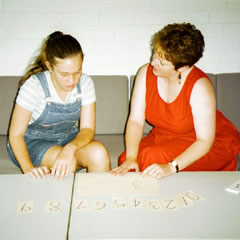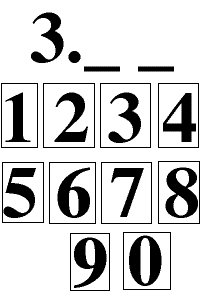|
 Introduction Introduction
Courtney cannot make either the biggest or the smallest numbers.
She interprets the decimal part as the denominator of a fraction.
She then uses her fraction knowledge that "the more pieces
something is divided into, the smaller each one is".
Comments: Text in italics
Interviewer: Text in red
Courtney: Text in other colour
Interviewer:
I have a number that starts 3 point something something... |

Interviewer:
and you get to choose the rest of the number...
|

Interviewer:
Here are the cards to choose from marked 0,1,2,3,4,5,6,7,8
and 9. I'm going to ask you to make the biggest number that
you can by choosing any two of these cards.
|

Courtney chooses only one card to make 3.1
Courtney:
Well, it might be 3 point 1 but I'm not
sure.
Interviewer:
Tell me what you're thinking.
Courtney:
Well, if it was three point two or three
point seven eight then there'd be more pieces so they'd have to
be smaller. So I guess just three point one.
Interviewer:
OK, what about if you have to choose two of
the cards to make your number?......
|

Courtney makes 3.01
|

Interviewer:
Could we just look at those two numbers that
you made? Did you make it bigger or smaller when you changed it?
 Courtney: Courtney:
Ummm, I think they're the same...cause the
zero doesn't matter....
|

Interviewer:
OK, now we'll put those cards back ....and
could you make another number, this time as small as you can?
|

Courtney:
Three point nine eight would be the
smallest
Interviewer:
Why's that?
Courtney:
Because if it's cut into lots of pieces,
they must be small.
|







 Introduction
Introduction